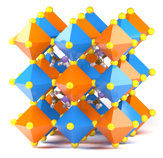Professor Tony Cheetham (Department of Materials Science and Metallurgy) and Professor Richard Friend (Optoelectronics Group)
The rapid increase in efficiency of perovksite based solar cells, which are now approaching that of commercial Si, has led to huge excitement in the research community. Although there are many scientific challenges to address the future is promising for this technology to provide a low-cost viable solution to harness solar energy.
This interdisciplinary project brings together Professor Tony Cheetham (Department of Materials and Metallurgy) working with a number of researchers in Physics including Professor Richard Friend, Dr Felix Deschler (Optoelectronics Group) and Dr Siân Dutton (Quantum Matter Group). The project will explore the relationship between the structure and chemistry of these hybrid perovskites and their opto-electronic properties. One of the aims is to develop an environmentally friendly alternative to the current system by making high efficiency lead-free hybrid devices.
Project Completed September 2016
This project provided Pump Prime support for a computational physicist (Dr Jung-Hoon Lee) to perform first principles calculations that could probe the fundamental properties of hybrid perovskites and guide their experimental synthesis. The calculations demonstrated the importance of hydrogen bonding in these systems and the effect this has on the tilting of the inorganic framework and subsequently the band gap. They also investigated the effect of replacing Pb with Bi in the archetypal hybrid perovskite MAPbI3 (MA = CH3NH3) and confirmed the stability and properties of the perovskite-related phase (NH4)3Bi2I9 which was synthesized. The Pump Prime support has stimulated further work by a research student on lead-free alternatives to CH3NH3PbI3 and this has led to the first systematic set of calculations on lead-free hybrid double perovskites, three of which have now been synthesized - (MA)2KBiCl6, (MA)2TlBiBr6 and (MA)2AgBiBr6 - and look to have promising optoelectronic properties. The project has produced a number of publications and forms part of the EPSRC-funded UKCP consortium on first principles simulations of materials. The combined computational-experimental approach continues.

The structure of (MA)2AgBiBr6

